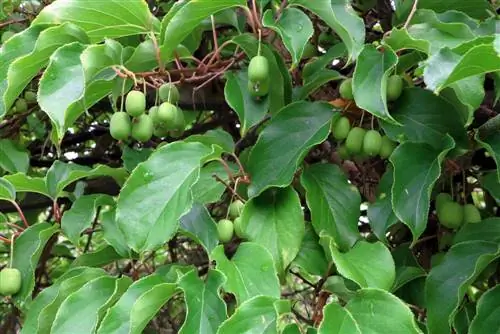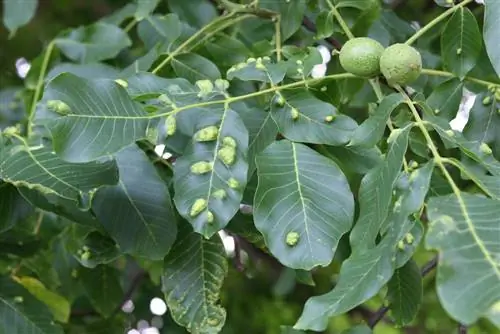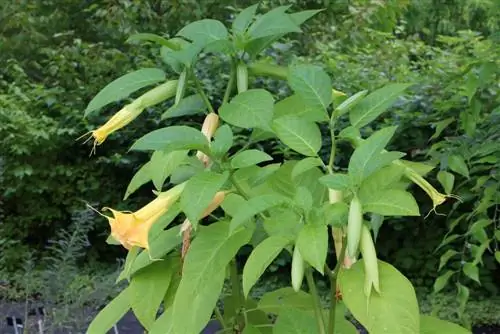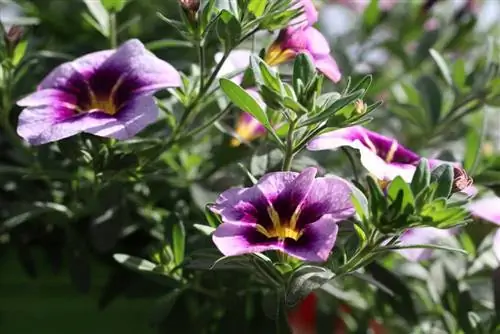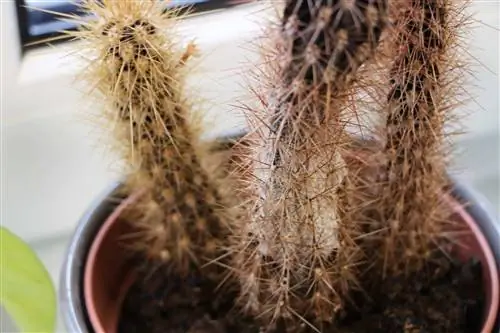- Author admin [email protected].
- Public 2023-12-17 03:39.
- Last modified 2025-01-24 12:45.
The kiwi is a popular fruit in these latitudes and is considered very tasty and, above all, very he althy. The plant can be easily cultivated in your own garden. Even though the kiwi plant is considered to be quite easy to care for and hardy, diseases and pests can also occur on this plant. What this is about is explained in the following article.
Brown leaf edges
If the kiwi plant shows brown leaf edges, then this is not directly a disease but rather an acute lack of water. The plant needs a lot of water, but waterlogging should be avoided. If the brown edges appear on the leaves, you should immediately proceed as follows:
- water well immediately
- remove all damaged leaves
- dispose of on the compost heap
- Check branches and shoots
- these may also already be dry
- if yes, then remove
Tip:
To avoid drought, the kiwi must be watered regularly, especially on very hot days. Use the early morning or late evening hours for this. Do not water over the leaves, flowers or fruits.
Chlorosis
Chlorosis is primarily seen on very light to faded leaves. In such a case the ground is very wet and compacted. Then, even if fertilization is carried out regularly, the nutrients can no longer be absorbed through the roots. Above all, the kiwi suffers from iron deficiency in such a case. You can proceed against this as follows:
- Loosen the soil around the plant well
- Fix compost and sand
- so the soil cannot compact so quickly
- Provide plants with iron
- use special fertilizer for this
- Leaves turn a deep green again after a while
- possibly create drainage to prevent wet ground
Frost Damage
Even if the older kiwi plants are hardy, the young kiwis can suffer frost damage in the first few years. If the roots are also affected, the trees can no longer be saved. However, if the frost damage is only superficial, then the following measures should be taken:
- remove all affected branches
- possibly also cut the trunk down to the ground
- then new shoots form from the roots
Tip:
To prevent frost damage from occurring in the first place, we recommend planting the young trees only after the Ice Saints and protecting them well in the first four winters.
Limescale intolerance
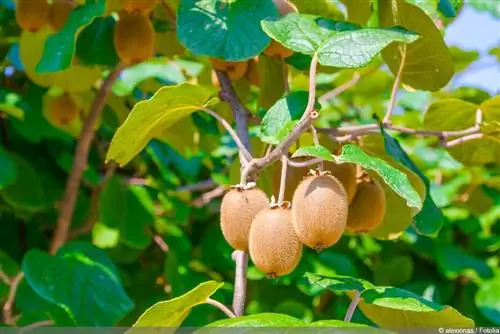
The kiwi plant does not tolerate lime and reacts very sensitively to it. The leaves hang and may fall off completely. If you water the plant regularly with water containing lime or even provide the plant with a fertilizer that contains a lot of lime, the kiwi will die completely and can no longer be saved. Therefore, you should pay particular attention to the following when caring for it:
- water only with rainwater
- alternatively stale and filtered tap water
- pay attention to the content of fertilizer
- fertilize without lime
Fungal infestation
If a summer is very wet and humid or if the kiwi plant is in the wrong location where it cannot dry out after a rainstorm, then fungal infestation can easily occur. This appears with light or brown spots on the leaves and fruits. Before the fungus can penetrate the entire plant, the following steps should be taken:
- dispose of all affected leaves and fruits
- put in the trash
- Fungus could multiply in the garden via the compost
- cut affected branches
- proceed with fungicides
- also treat the floor
- the fungus could survive here
- possibly change location
Tip:
If the fruits have already been infected by the fungus, they should no longer be consumed for the sake of he alth. Because even if only the outer shell is visibly affected, the fungus can have already penetrated the flesh of the fruit and then enters the human body through consumption.
Snails
The young plants in particular are affected by snail damage. The small kiwi plants are not very tall in the first year after planting and can therefore be easily reached by annoying pests. If snail damage is discovered on the tender leaves, action should be taken immediately. In the worst case scenario, the entire plant will be eaten away. The following steps can be taken against snails:
- natural snail barriers
- Sprinkle wood chips or sand around the plant
- Collect snails by hand in the evening
- Put out slug pellets
- Put a snail fence around the plants
Spider mites
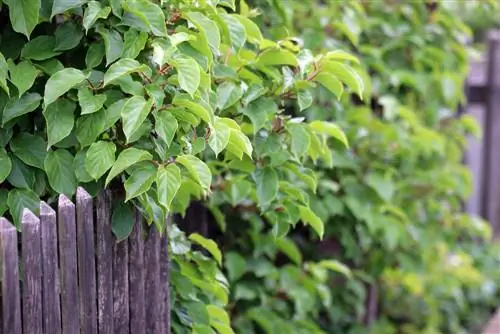
If the summer is very hot, then the kiwi should be checked for spider mites, which settle on the leaves in warm weather and suck them out. The pests are so small that they can hardly be seen with the naked eye, but webs form on the leaves and an infestation is quickly apparent. If spider mites appear on the kiwi, you should immediately proceed as follows:
- shower with a hose
- repeat several days in a row
- Remove any affected leaves
- also the affected shoots
- do not add to compost
- otherwise the pests will spread further
- better to dispose of in residual waste
- use predatory mites as a natural weapon
- also gall midge species Feltiella
- both are offered on the Internet
The natural predators of spider mites are also suitable and usable outdoors and prefer the same warm temperatures as the pests. If all the spider mites are destroyed, the predatory mites and mosquitoes also die due to a lack of food. The plant itself is not damaged by these insects.
Tip:
Chemical insecticides should be avoided on the kiwi plant, even if the fruits are only eaten peeled. There are always chemical particles that can penetrate through the peel into the fruit and be absorbed when consumed.
Vitamin deficiency
Especially when the kiwi receives too little fertilizer and then suffers from a nutrient and vitamin deficiency, it often becomes infested with pests or diseases. A he althy and vital plant can defend itself better against external influences and is more resilient. Therefore, regular fertilization with the right minerals and nutrients is important to keep the kiwi plant he althy. When fertilizing, you should proceed as follows:
- Kiwi wants slightly acidic soil
- avoid limescale
- Use rhododendron or azalea fertilizer
- add compost once in the spring
- fertilize every two to three weeks afterwards
- pay attention to manufacturer information
- stop fertilization from August
Root rot
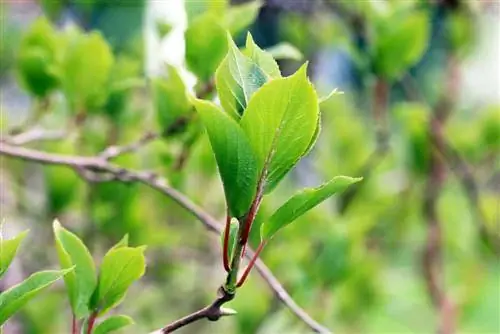
If the kiwi suffers from root rot, this is reflected in yellow-brown, often limp leaves. Root rot should be considered, especially if it has been watered enough. This occurs especially when there is waterlogging and can cause massive damage to the plant. Therefore, when planting, drainage made of gravel or stones should be created in the planting hole so that excess irrigation and rain water can drain away easily. If root rot is discovered, the following measures should be taken immediately:
- Dig up the roots carefully
- Carefully expose larger plants
- remove all damaged roots
- Let the root ball dry
- Let the soil dry out
- possibly mix with sand for better permeability
- only insert again after drying
If the roots have already been massively damaged by rot, then the plant is unfortunately lost and should be disposed of.

